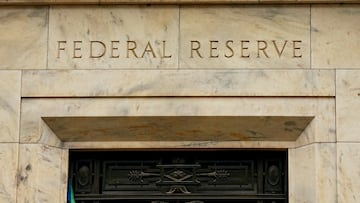The history of U.S. interest rates: 70 years of ups and downs
As the Fed prepares to announce its latest decision on interest rates, we take a look at the central bank’s key duties - and how it has juggled them over the years.


The U.S.’s Federal Reserve is expected to cut interest rates at this week’s meeting of the Federal Open Market Committee (FOMC), with the central bank likely to prioritize jobs growth.
Boosting employment is one half of a dual mandate that has, over the years, led the Federal Reserve to implement interest rates that have experienced extreme ups and downs.
Since the Fed began systematically publishing its federal funds rates in the mid-20th century, indeed, they have ranged from next to nothing - to nearly five times their current levels.
Why is the Fed set to cut interest rates?
This week’s anticipated cut in the Federal Reserve’s federal funds rate comes against the backdrop of disappointing jobs numbers in the U.S.
The most recent report by the country’s Bureau of Labor Statistics (BLS), released in September, showed just 22,000 jobs were added to the American economy during the previous month.
While the ongoing government shutdown has prevented the BLS from issuing its October report, estimates elsewhere place employment growth in September at around 60,000 jobs.
By comparison, the U.S. averaged a gain of 186,000 jobs per month in 2024, according to BLS statistics.
How much might Fed cut interest rates by?
Led by Chairman Jerome Powell, the Fed is meeting over two days this week, and is scheduled to announce its latest interest-rates decision at 2:00 p.m. ET/11:00 a.m. PT today, Wednesday October 29.
In September, the Federal Reserve reduced its target rate by 0.25%, to 4.00%-4.25% - the central bank’s first rates cut in nine months.
Experts now expect the Fed to apply the same reduction once again, with CME Group’s Fed Watch offering a 99.9% chance of another 0.25% interest-rate drop.
Speaking earlier this month, Powell appeared to indicate that the Fed’s current thinking remains in step with its mindset in September, noting that hiring in the U.S. is still “low”.
“Based on the data that we do have, it is fair to say that the outlook for employment and inflation does not appear to have changed much since our September meeting four weeks ago,” the 72-year-old told a speech at the National Association for Business Economics.
How would an interest-rate cut help jobs growth in the U.S.?
As the Federal Reserve outlines in its mission statement, one of the body’s two chief responsibilities is to “promote maximum employment”.
The Fed can do this by keeping interest rates down, which makes it cheaper for businesses and consumers to borrow money. This, in theory, will foster economic activity and create an environment in which firms are likelier to be hiring.
The Fed’s other chief duty is to ensure stable prices for American consumers, by keeping inflation in check. The constant conundrum for the central bank is that this second key responsibility involves taking opposite action on interest rates.
While the body can help create jobs by reducing the cost of borrowing and boosting economic activity, this can also lead prices to rise, by increasing the level of demand for goods and services.
So if inflation climbs, the Fed can stem this upward movement by raising interest rates, a move that makes borrowing less attractive and dampens demand.
However, while inflation in the U.S. remains above the Fed’s stated target of 2%, BLS statistics for September prices showed only a marginal rise on the inflation figures for August, from 2.9% to 3.0% - an uptick below economists’ forecasts. (Albeit it arrived late, the BLS did manage to publish an inflation report this month, despite the shutdown.)
“Overall, the inflation data will likely add fuel to expectations that the Federal Reserve [is] to cut interest rates by another quarter percentage point at its policy meeting,” say NPR financial experts Maria Aspan and Scott Horsley.
How the Fed has acted on inflation and growth over the years
Although the Federal Reserve currently appears to be prioritizing economic growth, the post-pandemic period in the U.S. was initially characterized by a significant focus on acting to bring consumer prices down.
Indeed, inflation in America surged to a 40-year high in mid-2022 - reaching 9.1% that June - leading the Fed to implement a series of aggressive interest-rate hikes, raising rates to levels not seen for over 15 years.
This frenzy of increases followed a slashing of interest rates to almost zero during the height of the pandemic. Amid an economic crisis caused by covid-enforced lockdowns, this was a strategy aimed at supporting spending. The Fed had also adopted such a rate-cut tactic in response to the Great Recession - a sharp decline in global economic activity between 2007 and 2009.
Aside from the inflation surge that hit the U.S. immediately after covid, a further notable example of an economic climate that required extreme Fed action to tackle rising prices came in the late 1970s and early 80s, when inflation rocketed to as high as 14.6%.
So severe were the central bank’s measures against surging prices, indeed, that interest rates peaked at just under 20% in 1981, at the height of the inflation crisis.
At a glance - how interest rates have evolved over the decades:
🇺🇸 U.S. Interest Rates over time (average):
— World of Statistics (@stats_feed) October 28, 2025
1954: 1.01%
1955: 1.79%
1956: 2.73%
1957: 3.11%
1958: 1.57%
1959: 3.31%
1960: 3.22%
1961: 1.96%
1962: 2.71%
1963: 3.18%
1964: 3.50%
1965: 4.08%
1966: 5.11%
1967: 4.22%
1968: 5.66%
1969: 8.20%
1970: 7.18%
1971: 4.66%
1972: 4.43%
1973:… https://t.co/SXuPzHHFo4
Related stories
Get your game on! Whether you’re into NFL touchdowns, NBA buzzer-beaters, world-class soccer goals, or MLB home runs, our app has it all.
Dive into live coverage, expert insights, breaking news, exclusive videos, and more – plus, stay updated on the latest in current affairs and entertainment. Download now for all-access coverage, right at your fingertips – anytime, anywhere.


Complete your personal details to comment